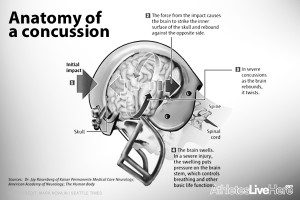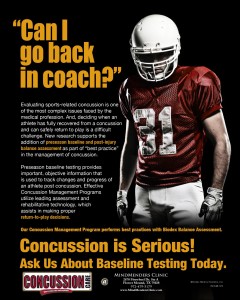@alcaruso3[/author_info] [/author]
As athletes around the country continue to play sports, their athletic trainers – and even their parents- have become more vigilant than ever before about concussions.
More athletes are suffering from this type of brain injury than in the past. But, all concussions are not created equal.
There have been cases where the athlete suffers the symptoms immediately following the injury, while in other instances, there’s been delayed concussions, where symptoms can appear days later.
“The incidence rate of concussions have increased in the past 10-years, or so, but this may reflect an increased awareness of the injury (i.e. better recognition of symptoms leading to an increase in the reporting of concussions),” said Michael Clark, a research assistant at Matthew A. Gfeffer Sport-Related Traumatic Brain Injury Research Center at The University of North Carolina at Chapel Hill. “It is unclear if the incidence rate reflects more concussions occurring, or a decrease in the number that are unreported so students can continue to play. Most think increased recognition.
“That said, there is still a major problem of underreporting. That is, athletes, who are concussed, but say nothing to their coach, their athletic trainer, parents, doctor, etc. Some estimates put this rate at about 50% though it is exceedingly difficult to study something that is by definition unreported. Increasing efforts towards prevention is a major focus. Particularly for rural athletic programs without a dedicated athletic trainer.”
 According to The Centers for Disease Control and Prevention, there are anywhere between 1.6 million to 3.8 million concussions per year. About 5-to-10% of athletes will experience a concussion in the sport that they play.
According to The Centers for Disease Control and Prevention, there are anywhere between 1.6 million to 3.8 million concussions per year. About 5-to-10% of athletes will experience a concussion in the sport that they play.
The Head Case Company suggests that 33% of the concussions that happen in sports happen while at practice. Those with multiple concussions (39%) have shown an increase in catastrophic head injury, which leads to a permanent neurologic disability.
Of all the concussions reported, 47% of them have come from high school football. In fact, the concussion rate is between 64-76.8% for that sport.
“It’s a physical sport by nature with high speeds and physicality,” Clark added. “There’s no rocket science to this one; it is an inherent risk.”
The dangers of playing football has been documented for a long time. Even star athletes, like LeBron James, Terry Bradshaw, Troy Aikman, Drew Brees, Kurt Warner, Brett Favre and others, do not want their children to play this gladiator sport.
“It’s always a conversation that we encourage parents and their children to have,” Clark said. “There is no strong evidence of a lasting effect of a single concussion. Most of the long-term consequences seem to be associated with repetitive trauma. That said, those who have been concussed are at a greater risk of having another concussion. There are benefits to sports participation and these should be weighed against the risk of concussions.”
Besides football, there’s been documented concussion rates for such sports as ice hockey through baseball.  Ice Hockey is the second highest with 54% behind football, while baseball has the lowest rate at 4.6-5% in terms of athletes participating in the sport.
Ice Hockey is the second highest with 54% behind football, while baseball has the lowest rate at 4.6-5% in terms of athletes participating in the sport.
Many professional leagues have policies in place for concussions. The NFL has been the biggest advocate, as they put sensors in player’s helmets and other precautions on the sidelines. They even have a trained medical person in a suite to overlook players on the field and can call down to take them out for a play or the game.
In July 2014, a federal judge approved a landmark deal that would settle a lawsuit agreement for former NFL players, who had concussion-related claims. There were more than 4,500 former players, who were involved in the lawsuit.
With this settlement, the payment will last about 65-years. It also covered retired players, who suffered from other neurological problems. And also includes those former players, who developed Lou Gehrig’s disease.
Anita Brody, a U.S. District Judge in Philadelphia, insisted that $675 million be paid to the former players, who suffer neurological problems. Additionally, $75 million for baseline testing and another $10 million for medical research and education were to be paid by the NFL.
She also said that the NFL had to pay for the players’ lawyers, which was $112 million. The grand total was $870 million.
“Unfortunately for the NFL, most of these lawsuits focus on negligence that has already happened,” Jonathan Brown, Sports Economics Professor, Rutgers University said. “In that sense, there’s nothing they can do, except to wait to see how much more information rolls in, and change their practices going forward. If they’d like to protect themselves from this point on, they’ll have to acknowledge the issue of concussions and their long-term effects, and monitor their athletes much more closely. This medical coverage should extend well beyond a player’s tenure in the league. They will potentially have to change the way that the game is played, banning certain hits, and providing harsher penalties to those who break the rules.”
In October 2009, Congress wanted answers on if the league was doing enough for this serious issue.
“The NFL is not doing enough to be proactive, in my opinion,” Brown added. “As far as I know, they’re not even monitoring their athletes enough. This is to say nothing of what do with the information that is gathered during the monitoring process. All information gathered should be interpreted with the players’ best interest in mind, not the League’s. This is unfortunately not how firms tend to operate. The players’ union will have to battle to not only create a system in which the information is gathered and made available, but also an environment [where] the players’ long-term health is a top priority.
“The tricky part comes in a labor market. If players become very conservative when it comes to their health and safety, they will most likely see a dip in wage. This is the nature of monopsony, in which the NFL has such great bargaining power over players. There’s not another professional football league, at least not of NFL caliber, that will compete with the NFL on wages.”
 On Christmas Day, there will be a movie out on theaters called “Concussion” featuring Will Smith. This comes out after a real-life situation arose when Dr. Bennet Omalu, found chronic traumatic encephalopathy (CTE) in the brain of former Steeler Mike Webster.
On Christmas Day, there will be a movie out on theaters called “Concussion” featuring Will Smith. This comes out after a real-life situation arose when Dr. Bennet Omalu, found chronic traumatic encephalopathy (CTE) in the brain of former Steeler Mike Webster.
In addition, a brain injury study, which was conducted by the CTE Center at Boston University, showed that 33 of the 34 players tested post-mortem had CTE.
“I think the movie will do absolutely fine financially and probably fine critically from a cinema standpoint,” Brown acknowledged. “Will Smith generally has mass appeal. I can’t be sure of the reviews, obviously, but the company is confident enough to release it during Oscar season and the trailer looks quite good. I’m less sure of the culture impact it will have in terms of how it will affect the NFL. It’s hard to say how many people will see the movie and begin to boycott the NFL on Sunday’s. Again, the NFL fan base is very loyal.”

